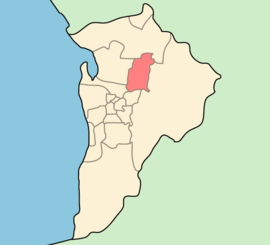District Council of Tea Tree Gully
|
City of Tea Tree Gully South Australia |
|||||||||||||||
|---|---|---|---|---|---|---|---|---|---|---|---|---|---|---|---|
 |
|||||||||||||||
| Population | 98,861 (2015 est) | ||||||||||||||
| • Density | 1,038/km2 (2,690/sq mi) | ||||||||||||||
| Established | 1858 | ||||||||||||||
| Area | 95.21 km2 (36.8 sq mi) | ||||||||||||||
| Mayor | Kevin Knight | ||||||||||||||
| Council seat | Modbury | ||||||||||||||
| Region | Northern Adelaide | ||||||||||||||
| State electorate(s) | Little Para, Florey, Newland, Playford, Torrens, Wright | ||||||||||||||
| Federal Division(s) | Mayo, Makin, Sturt | ||||||||||||||
 |
|||||||||||||||
| Website | City of Tea Tree Gully | ||||||||||||||
|
|||||||||||||||
The City of Tea Tree Gully is a local council in the Australian state of South Australia, in the outer north-eastern suburbs of Adelaide. The city has an estimated population of 98,861 people and is one of the most populous local government divisions in Adelaide. The major business district in the city is at Modbury, where Tea Tree Plaza, the Civic Centre and the library are located.
Howard, Lord Florey, Australian pathologist and co-discoverer of penicillin, was a resident of the City of Tea Tree Gully. [1]
The current council as of June 2017[update] is:
The Tea Tree gully itself passes through the Adelaide foothills roughly marking the easiest path eastwards from Grand Junction Road to Gumeracha. The 1850s settlement at the entrance to the gully (approximately where North East Road enters the foothills) was known as the village of 'Steventon' after a local resident, John Stevens, who was a major landowner in the area. The name Steventon is retained as one of the electoral wards of the City of Tea Tree Gully.
The council was originally proclaimed in October 1858 as the District Council of Tea Tree Gully, when the northern half of the District Council of Highercombe, which had been created in 1853, successfully seceded to form its own municipality. In the early 1930s, the two councils were considered unviable, being very small in relative size and population. The District Council of Highercombe was included in a Local Government Commission list of 53 local councils with annual revenue of less than £2000. Following the commission recommendation, the two councils were recombined under the name Tea Tree Gully in May 1935.
...
Wikipedia
